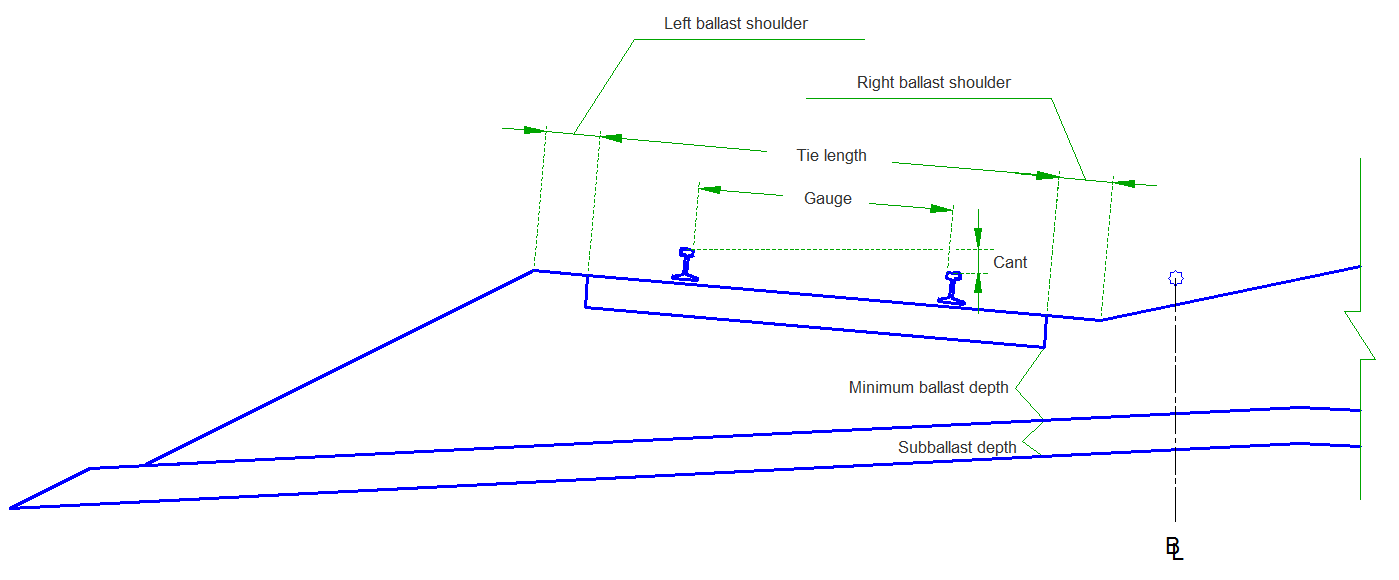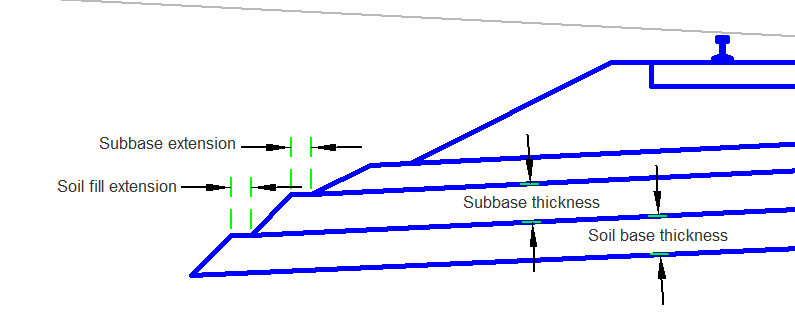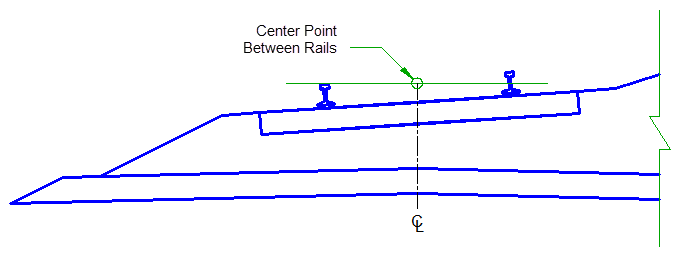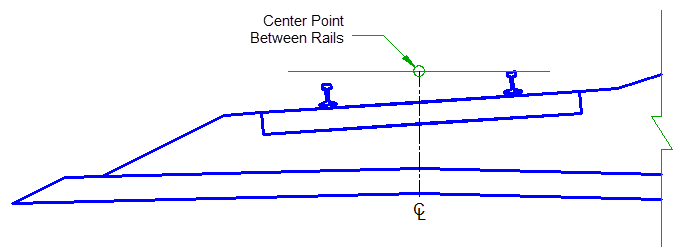The RailDoubleTrackCANT subassembly is used to insert the rails, ties, ballast, subballast, soil fill, and subbase for a double-track railroad.
It should be followed with a Daylight subassembly on the left and right sides to close to existing ground in cut and fill situations. It is capable of responding to rail cant.



Attachment
By default, the attachment point is at the centerline between the rails of the left track. The tracks can be moved relative to this point using the subassembly parameters.
Input Parameters
|
Parameter |
Description |
Type |
Default |
|---|---|---|---|
| Measure Cant At |
Determines whether the elevation difference between rails takes place between the gauge line (face) of each rail or CL of each rail. |
Selection List:
|
CL Rail to CL Rail |
| Default Cant |
The default elevation difference between rails. The value is positive when the right rail is higher than the left and negative when the right rail is lower than the left. This value is applied in layout mode and is helpful for observing how the subassembly reacts to different cant values. This value is overridden by cant when it is present via the baseline alignment. |
Numeric |
0 |
| Drainage Channel Depth | Depth of drainage channel from top of ballast. | Numeric, non-negative |
0.5 ft 0.1524 m |
| Gauge |
The distance between the inside faces of the rails |
Numeric, non-negative |
56.5" 1435 mm |
| Baseline to Right Track CL |
The offset from the baseline alignment to the centerline of the left or right track. |
Numeric |
0 |
| Baseline to Left Track CL |
The offset from the baseline alignment to the centerline of the left or right track. |
Numeric |
20' 6m |
| Track Elevation Difference (Left and Right) |
The vertical offset between the profile grading point of the baseline and the center point between the tracks. This value is overridden when an elevation target is applied to the track. |
Numeric |
0 |
| Rail Head Width |
Width of the rail head. |
Numeric, non-negative |
2. 72" 69 mm |
| Rail Depth |
Depth of rail from top of rail to top of tie plate |
Numeric, non-negative |
6.625" 168 mm |
| Rail Base Width |
Width of the base of the rail |
Numeric, non-negative |
5.5" 0.14 m |
| Tie Plate Thickness |
Thickness of the tie plate which is also the distance from the bottom of the rail to the top of the tie. |
Numeric, non-negative |
1" 25 mm |
| Rail Base to Ballast |
Distance from the bottom of the rail to the top of the ballast. If this value is equal to the tie plate thickness, then the top of the ballast is flush with the tops of the ties. |
Numeric, non-negative |
1" 25 mm |
| Tie Length |
Length of the tie (also known as sleeper). |
Numeric, non-negative |
8.5' 2.59 m |
| Tie Depth |
Depth of tie |
Numeric, non-negative |
7" 178 mm |
| Minimum Ballast Depth |
The minimum vertical distance between the bottom of the tie and the top of the Subballast. The location of this minimum distance changes at different stages in cant. See "Behavior" below. |
Numeric, non-negative |
12" 305 mm |
| Ballast Shoulder Width (Left and Right) |
The distance from the end of the tie to the beginning of the ballast side slope. |
Numeric, non-negative |
1 ft 0.30 m |
| Ballast Side Slope (Left and Right) |
The slope of the side of the ballast material. The slope of the top of the ballast material matches the slope of the tie that results from cant. |
Slope, non-negative |
2:1 |
| Subballast Depth |
The depth of the subballast material |
Numeric, non-negative |
8" 203 mm |
| Baseline to Subballast Crown |
The offset from the baseline to the crown of the subballast. |
Numeric |
10' 3 m |
| Subballast Top Slope |
The top slope of the left and right sides of the subballast with the centerline of the subassembly as the hinge point. |
Slope, non-negative |
40:1 |
| Subballast Extension (Left and Right) |
The distance from the toe of the ballast material to the beginning of the side slope of the subballast material |
Numeric, non-negative |
12" 0.30 m |
| Subballast Slope |
The slope of the side of the subballast material. |
Slope, non-negative |
2:1 |
| Omit Rails |
Prevents the rail points, links, and shapes from being drawn. |
Yes/No |
No |
| Omit Ties |
Prevents the tie points, links, and shapes from being drawn. |
Yes/No |
No |
| Omit Ballast |
Prevents the ballast points, links, and shapes from being drawn. If this option is set to Yes then the subballast is also not drawn. |
Yes/No |
No |
| Omit Subballast |
Prevents the subballast points, links, and shapes from being drawn. If the Omit Ballast option is set to Yes then the subballast is not drawn regardless of this setting. |
Yes/No |
No |
| Omit Soil Fill |
Prevents the soil fill points, links, and shapes from being drawn. If the Omit Ballast or Omit Subballast option is set to Yes then the soil fill is not drawn regardless of this setting. |
Yes/No |
No |
| Sub_Base Slope |
The slope of the side of the SubBase material. |
Slope, non-negative |
1:1 |
| Sub_Base Extension |
The distance from the toe of the subballast material to the beginning of the side slope of the SubBase material |
Numeric, non-negative |
0.5' 150 mm |
| Sub_Base Depth |
The depth of the SubBase material |
Numeric, non-negative |
12" 300 mm |
| Omit SubBase |
Prevents the SubBase points, links, and shapes from being drawn. If the Omit Ballast, Omit Subballast, or Omit Soil Fill option is set to Yes then the SubBase is not drawn regardless of this setting. |
Yes/No |
No |
| Soil Fill Slope |
The slope of the side of the Soil Fill material. |
Slope, non-negative |
1:1 |
| Soil Fill Depth |
The depth of the Soil Fill material |
Numeric, non-negative |
12" 300 mm |
| Soil Fill Extension |
The distance from the toe of the soil fill material to the beginning of the side slope of the Subballast material. |
Numeric, non-negative |
0.5' 150 mm |
Target Parameters
This section lists the parameters in this subassembly that can be mapped to one or more target objects. For more information, see To Specify Corridor Targets.
|
Parameter |
Description |
Status |
|---|---|---|
|
Left Track Offset |
May be used to set the horizontal location of the centerline of the left track. |
Optional |
|
Right Track Offset |
May be used to set the horizontal location of the centerline of the right track. |
Optional |
|
Left Track Elevation |
May be used to set the elevation of the center point between the left rails. Cant is applied after this point is located so the actual point between rails may vary since rotation can occur around either of the rails. |
Optional |
|
Right Track Elevation |
May be used to set the elevation of the center point between the right rails. Cant is applied after this point is located so the actual point between rails may vary since rotation can occur around either of the rails. |
Optional |
Runtime Logical Assignments
None.
Output Parameters
None.
Behavior
When no targets are applied, the location of either track is determined by the Left Track Offset, Right Track Offset, Left Track Elevation Difference, and Right Track Elevation Difference. These values locate the center points between the tracks. By default, the Left Track Offset is zero placing the centerline of the left track at the baseline. When target alignments and profiles are applied, these values are overridden. When using target alignments for the track centerlines, the tracks always remain perpendicular to the baseline, not the target alignment. When the target alignments are not parallel to the baseline alignment, distortion will occur and the track dimensions will not be accurately represented.

If you set the Pivot Method to High Side Rail, then the rail on the outside of the curve is held at track elevation and the elevation of the inside rail is adjusted an amount equal to the cant value.

If you set the Pivot Method to Center Baseline, then both rails are adjusted an amount equal to half the cant value, the outside rail upward and inside rail downward.

The Minimum Ballast Depth value applies at the location of the minimum clearance between the tie and subballast. The Subballast Top Slope parameter independently controls the subballast top slope . The Baseline to Subballast Crown parameter controls the location of the subballast crown.
Layout Mode Operation
In layout mode the subassembly displays the links comprising the rails, tie, ballast, subballast, and side slopes.
Point, Link, and Shape Codes
The following table lists the point, link, and shape codes for this subassembly that have codes assigned to them. Point, link, or shape codes for this subassembly that do not have codes assigned are not included in this table.
|
Point, Link, or Shape |
Code |
Description |
|---|---|---|
| L32 | Ballast,Ballast_Between_Ties | Ballast material in open space between ties. Can also be used when ties are omitted. |
| L116-L119 | Top, SoilFill | SoilFill |
| L120-L121 | SoilFill, SubBase" | SoilFill |
| L122-L125 | Top, SubBase | SubBase |
| L126-L127 | SubBase, Datum | SubBase |
| S1, S2 | Rail | Rails |
| S3 | Tie | Tie |
| S4 | Ballast | Ballast |
| S5 | Subballast | Subballast |
| S6 | SubBase | SubBase |
| S7 | SoilFill | SoilFill |
Coding Diagrams


